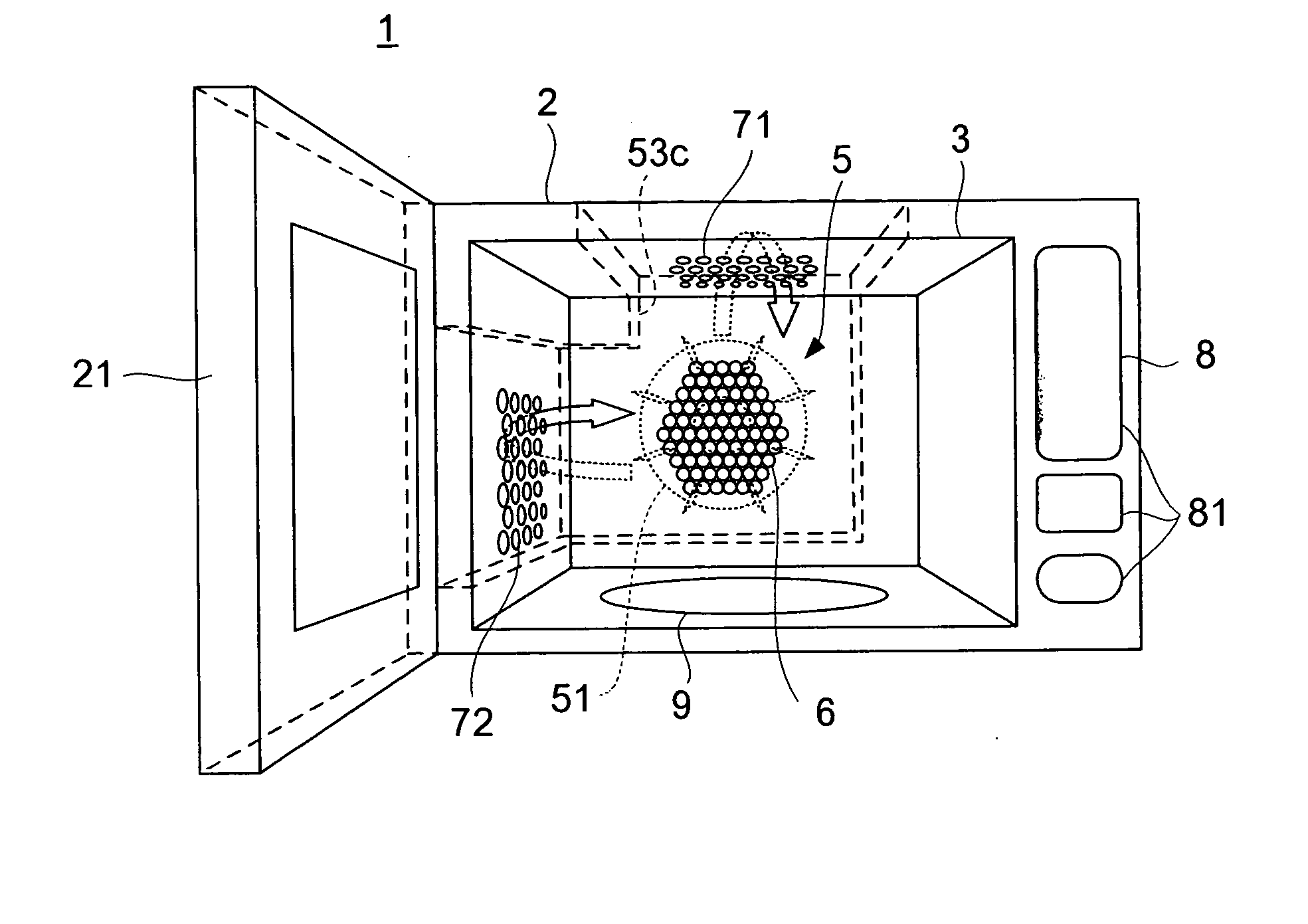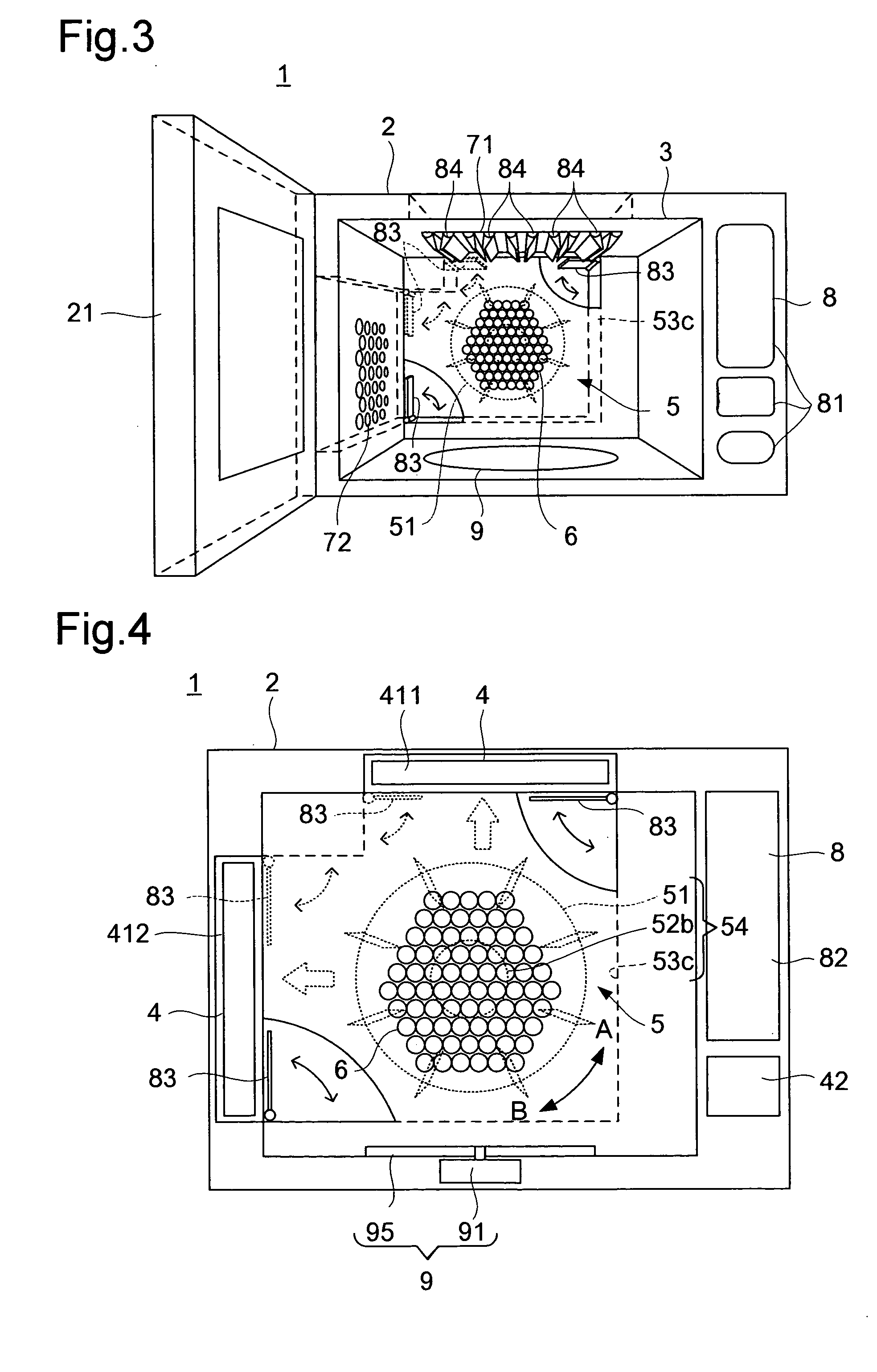Cooking device
a technology of cooking device and cooking time, which is applied in the field of cooking device, can solve the problems of increasing power consumption but not noise, requiring rather a long time for cooking, and achieve the effects of enhancing cooking performance, shortening cooking time, and no degradation of cooking performan
- Summary
- Abstract
- Description
- Claims
- Application Information
AI Technical Summary
Benefits of technology
Problems solved by technology
Method used
Image
Examples
first embodiment
[0099] Inside the two-way branch fan casing 53c, there is provided a damper device 83. The damper device 83 permits adjustment of the wind volumes sent from the blowing machine 54 in the direction of the ceiling-surface blowoff port 71 and in the direction of the side-surface blowoff port 72. Moreover, at the ceiling-surface blowoff port 71, there is provided a throttling device 84. The throttling device 84 permits adjustment of the wind speed blown out via the ceiling-surface blowoff port 71. In other respects, the cooking device 1 of this embodiment is constructed in the same manner as the cooking device 1 of the first embodiment, and therefore such components as are common to the two embodiments are identified with the same reference numerals, and their explanations will not be repeated.
[0100] Constructed as described above, the cooking device 1 of this embodiments offers the same effects as the cooking device 1 of the first embodiment. In addition, in this embodiment, by control...
fifth embodiment
[0116] In the ceiling surface of the heating chamber 3, there is provided a blowoff port 7 provided with a throttling device 84. The air sucked in via the suction port 6 by the blowing machine 54 is heated by the heater 41, and is blown out via the blowoff port 7 into the heating chamber 3. Meanwhile, the wind speed of the air thus blown out is adjusted by the throttling device 84. In other respects, the cooking device 1 of this embodiment is constructed in the same manner as the cooking device 1 of the fifth embodiment, and therefore such components as are common to the two embodiments are identified with the same reference numerals, and their explanations will not be repeated.
[0117] In the cooking device 1 constructed as described above, when the user puts a cooking target on a meshed rack (not illustrated) placed on the turntable 95 and enters instructions via the operation panel 81 (see FIG. 1), according to the instructions entered via the operation panel 81, the controller 82 ...
seventh embodiment
[0146] Constructed as described above, the cooking device 1 of this embodiments offers, in addition to the effects offered by the cooking device 1 of the seventh embodiment, the following effects.
[0147] When the centrifugal fan 51 is rotated by the reversible motor 52B at a high rate in the direction indicated by arrow A shown in FIG. 15, the wind volume that passes through the air-blow passage 56a becomes far higher than the wind volume that passes through the air-blow passage 56b. Moreover, since the air-blow passage 56a becomes increasingly large along the air-blow direction, it functions as a so-called diffuser by converting the kinetic energy of the flowing wind into a static pressure. This greatly augments the wind guided upward from the heater 41 as compared with the same wind in the cooking device 1 of the seventh embodiment. This enhances the performance of the centrifugal fan 51, and thus, even if the rotation rate of the centrifugal fan 51 is made lower than in the cookin...
PUM
 Login to View More
Login to View More Abstract
Description
Claims
Application Information
 Login to View More
Login to View More - R&D
- Intellectual Property
- Life Sciences
- Materials
- Tech Scout
- Unparalleled Data Quality
- Higher Quality Content
- 60% Fewer Hallucinations
Browse by: Latest US Patents, China's latest patents, Technical Efficacy Thesaurus, Application Domain, Technology Topic, Popular Technical Reports.
© 2025 PatSnap. All rights reserved.Legal|Privacy policy|Modern Slavery Act Transparency Statement|Sitemap|About US| Contact US: help@patsnap.com



